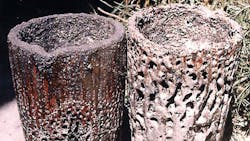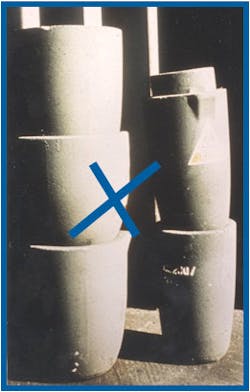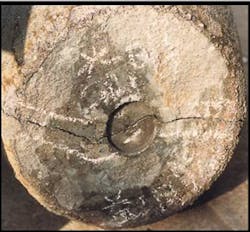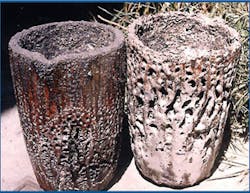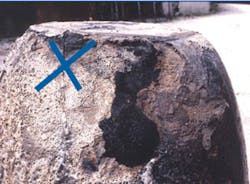Top 10 Ways to Maximize Crucible Service Life
Sometimes the difference between a crucible that consistently performs well and one that fails to meet even minimal standards may have nothing to do with the crucible itself. Rather, the performance difference may have everything to do with how the crucible is handled, operated and maintained at the foundry. For example, if some crucibles provide a long service life while other identical crucibles fail after a couple of heats, operating conditions at the foundry typically causes those premature failures. Often, following some basic operational procedures will eliminate early crucible failures. Here is a countdown list of the top ten ways to help you maximize your crucibles’ service life.
Check crucible for cracks and damage when received. Be sure to handle and store it properly. Improper handling easily damages crucibles. When a new crucible arrives, inspect it carefully for chips, cracks and abrasions and never put a damaged crucible into service. Also, when moving crucibles to a furnace or into storage, never roll them: this damages the protective glaze. And, never stack crucibles one inside the other because they will crack. Finally, never sit them directly on a concrete surface because they will absorb water on the bottom.
9. Install crucibles according to the manufacturer’s instructions. While installing a crucible is quick and easy, care must be taken to follow the instructions regarding base size, clearances between the crucible and the furnace and the initial preheating of the crucible. Too small a base may fail to provide sufficient support, and the wrong base height in a fuel-fired furnace may cause the burner flame to create an overheated and oxidized area on the crucible. Insufficient clearances between the crucible and the furnace sides and top may cause cracking when the heated crucible expands. Also, insufficient initial heating may result in crucible failure on first use.
8.Prevent thermal shock with proper preheating. While some types of crucibles are designed to resist damage from rapid heating, all crucibles require careful preheating if allowed to cool between melts. Thermal shock causes cracking in crucibles heated too quickly. Follow specified preheating recommendations.
7. Every crucible has a maximum temperature limit. If you exceed that limit the crucible will be damaged and may fail. Keep close control of crucible temperatures. Allowing molten metal to solidify in the crucible also may damage the crucible when that metal is reheated for pouring.
6. Avoid physical damage by charging correctly and carefully. Dropping a heavy casting or ingot into a furnace crucible may chip or crack the crucible, leading to failure. Follow proper charging practice of first loading small charge materials and then carefully lowering heavier materials on top of cushioning base. It is important also not to pack charge materials tightly into the furnace. When wedged material is heated, it expands and can crack the crucible.
5. Guard against chemical attack by minimizing flux usage and adding flux only after metal is fully molten. All crucibles, even those designed to resist chemical attack, can be damaged flux additives. The most effective way to minimize this damage is to add flux only after the bath is fully molten and able to dilute the material. Adding flux with the solid charge allows the concentrated flux to attack the crucible surface during the melting process. It is important also to use the minimum amount of flux that is required.
In a fuel-fired furnace, operating the burner with excess air and direct flame impingement on the crucible surface will produce damaging oxidation of the crucible. In all furnaces, placing ceramic fiber between the crucible and its base or wedging ceramic fiber against the top edge of the crucible also will cause oxidation and cracking in those areas. Finally, allowing a metal bath to be held at a minimal temperate for a lengthy period of time will accelerate crucible oxidation.
3. Control dross build-up by cleaning regularly. Dross or slag build-up is bad in several ways. It has low thermal conductivity necessitating higher furnace temperatures. It absorbs flux and accelerates chemical attack on the crucible. And, its high expansion rate causes internal pressure on the crucible that can damage it. Follow a consistent program of frequent and thorough dross and slag removal, using a scraping tool that matches the curve of the crucible’s interior surface to avoid gouging.
2. Maintain a careful log of crucible use, inspect the crucible often, and replace it when worn or damaged. Keeping an accurate log of crucible use is essential to the effective and safe operation of crucibles. It allows you to create a history that will reveal what crucible service life you should anticipate in normal operations. With this information, you can set up a program of routine crucible replacement that will minimize downtime. However, such a program is not a substitute for frequent crucible inspections that may reveal wear or damage that requires immediate crucible replacement.
1. Select the right crucible for your operations and processes. Selecting the right tool for the job is essential for most tasks and crucibles are no exception. The most important way to maximize crucible service life is to begin by selecting the right crucible match for your application. You must consider the full range of metals and alloys you melt or hold, the type and size of the melting or holding furnace you use, the temperature ranges the crucible will experience, the rate of temperature change the crucible must sustain, the fluxes or additives to be used, your operating schedule, how the crucible will be charged and emptied, how the crucible will be handled, and how it will be maintained. With this information in hand, get recommendations from your crucible supplier. New crucibles types with enhanced performance characteristics are becoming available frequently and your supplier will keep you up to date with this information.
For more detailed information on this subject, visit Morgan Molten Metal Systems, www.morganmms.com.
